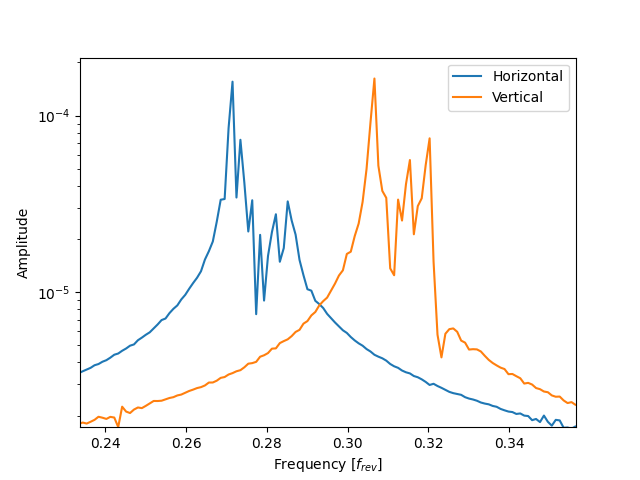Pipeline for multibunch simulations
Xsuite can be used to simulate multiple bunches interacting through collective forces, such as beam-beam interactions or wakefields. The xtrack.pipeline.MultiTracker handles the tracking of multiple xpart.particles.Particles objects through their own xtrack.Line (e.g. each of the two rings in a circular collider). Each Particles instance and its Line make a xtrack.pipeline.Branch. The MultiTracker will iteratively track its branches until an xtrack.beam_elements.Element which requires communication is reached (e.g. a strong-strong beam-beam collision, where information about the other beam’s charge distribution is required). At this point the MultiTracker will use the xtrack.pipeline.PipelineManager to establish communication between the branches that need to exchange information. If the communication cannot take place, e.g. because one of the two branches is not ready, the Multitracker resumes tracking with another branch.
The PipelineManager is aware of the communication required by the different Elements and the different Particles instances (e.g. in a collider with many bunches and many interactions points, the PipelineManager knows which bunch collides with which and where.) By default the PipelineManager uses a dummy communicator which does not require MPI, but an MPI communicator can be provided instead thus enabling tracking on multiple CPUs.
It is important that the Particles instances as well as the Element instances in the line that require communication through the pipeline are attributed a uniquely defined name.
The pipeline algorithm is detailed in https://doi.org/10.1016/j.cpc.2019.06.006.
The following example illustrates how to configure and run a simulation with two bunches colliding at two interaction points using MPI. It must be run like a MPI application
mpirun -np 2 python example.py
Example
import time
import numpy as np
from matplotlib import pyplot as plt
from mpi4py import MPI
import xobjects as xo
import xtrack as xt
import xfields as xf
import xpart as xp
context = xo.ContextCpu(omp_num_threads=0)
####################
# Pipeline manager #
####################
# Retrieving MPI info
comm = MPI.COMM_WORLD
nprocs = comm.Get_size()
my_rank = comm.Get_rank()
# Building the pipeline manager based on a MPI communicator
pipeline_manager = xt.PipelineManager(comm)
if nprocs >= 2:
# Add information about the Particles instance that require
# communication through the pipeline manager.
# Each Particles instance must be identifiable by a unique name
# The second argument is the MPI rank in which the Particles object
# lives.
pipeline_manager.add_particles('B1b1',0)
pipeline_manager.add_particles('B2b1',1)
# Add information about the elements that require communication
# through the pipeline manager.
# Each Element instance must be identifiable by a unique name
# All Elements are instanciated in all ranks
pipeline_manager.add_element('IP1')
pipeline_manager.add_element('IP2')
else:
print('Need at least 2 MPI processes for this test')
exit()
#################################
# Generate particles #
#################################
n_macroparticles = int(1e4)
bunch_intensity = 2.3e11
physemit_x = 2E-6*0.938/7E3
physemit_y = 2E-6*0.938/7E3
beta_x_IP1 = 1.0
beta_y_IP1 = 1.0
beta_x_IP2 = 1.0
beta_y_IP2 = 1.0
sigma_z = 0.08
sigma_delta = 1E-4
beta_s = sigma_z/sigma_delta
Qx = 0.285
Qy = 0.32
Qs = 2.1E-3
#Offsets [sigma] the two beams with opposite direction
#to enhance oscillation of the pi-mode
mean_x_init = 0.1
mean_y_init = 0.1
p0c = 7000e9
print('Initialising particles')
if my_rank == 0:
particles = xp.Particles(_context=context,
p0c=p0c,
x=np.sqrt(physemit_x*beta_x_IP1)
*(np.random.randn(n_macroparticles)+mean_x_init),
px=np.sqrt(physemit_x/beta_x_IP1)
*np.random.randn(n_macroparticles),
y=np.sqrt(physemit_y*beta_y_IP1)
*(np.random.randn(n_macroparticles)+mean_y_init),
py=np.sqrt(physemit_y/beta_y_IP1)
*np.random.randn(n_macroparticles),
zeta=sigma_z*np.random.randn(n_macroparticles),
delta=sigma_delta*np.random.randn(n_macroparticles),
weight=bunch_intensity/n_macroparticles
)
# Initialise the Particles object with its unique name
# (must match the info provided to the pipeline manager)
particles.init_pipeline('B1b1')
# Keep in memory the name of the Particles object with which this
# rank will communicate
# (must match the info provided to the pipeline manager)
partner_particles_name = 'B2b1'
elif my_rank == 1:
particles = xp.Particles(_context=context,
p0c=p0c,
x=np.sqrt(physemit_x*beta_x_IP1)
*(np.random.randn(n_macroparticles)+mean_x_init),
px=np.sqrt(physemit_x/beta_x_IP1)
*np.random.randn(n_macroparticles),
y=np.sqrt(physemit_y*beta_y_IP1)
*(np.random.randn(n_macroparticles)-mean_y_init),
py=np.sqrt(physemit_y/beta_y_IP1)
*np.random.randn(n_macroparticles),
zeta=sigma_z*np.random.randn(n_macroparticles),
delta=sigma_delta*np.random.randn(n_macroparticles),
weight=bunch_intensity/n_macroparticles
)
# Initialise the Particles object with its unique name
# (must match the info provided to the pipeline manager)
particles.init_pipeline('B2b1')
# Keep in memory the name of the Particles object with which this
# rank will communicate
# (must match the info provided to the pipeline manager)
partner_particles_name = 'B1b1'
else:
# Stop the execution of ranks that are not needed
print('No need for rank',my_rank)
exit()
#############
# Beam-beam #
#############
nb_slice = 11
slicer = xf.TempSlicer(sigma_z=sigma_z, n_slices=nb_slice)
config_for_update_IP1=xf.ConfigForUpdateBeamBeamBiGaussian3D(
pipeline_manager=pipeline_manager,
element_name='IP1', # The element name must be unique and match the
# one given to the pipeline manager
partner_particles_name = partner_particles_name, # the name of the
# Particles object with which to collide
slicer=slicer,
update_every=1 # Setup for strong-strong simulation
)
config_for_update_IP2=xf.ConfigForUpdateBeamBeamBiGaussian3D(
pipeline_manager=pipeline_manager,
element_name='IP2', # The element name must be unique and match the
# one given to the pipeline manager
partner_particles_name = partner_particles_name, # the name of the
#Particles object with which to collide
slicer=slicer,
update_every=1 # Setup for strong-strong simulation
)
print('build bb elements...')
bbeamIP1 = xf.BeamBeamBiGaussian3D(
_context=context,
other_beam_q0 = particles.q0,
phi = 500E-6,alpha=0.0,
config_for_update = config_for_update_IP1)
bbeamIP2 = xf.BeamBeamBiGaussian3D(
_context=context,
other_beam_q0 = particles.q0,
phi = 500E-6,alpha=np.pi/2,
config_for_update = config_for_update_IP2)
#################################################################
# arcs (here they are all the same with half the phase advance) #
#################################################################
arc12 = xt.LineSegmentMap(
betx = beta_x_IP1,bety = beta_y_IP1,
qx = Qx/2, qy = Qy/2,bets = beta_s, qs=Qs/2)
arc21 = xt.LineSegmentMap(
betx = beta_x_IP1,bety = beta_y_IP1,
qx = Qx/2, qy = Qy/2,bets = beta_s, qs=Qs/2)
#################################################################
# Tracker #
#################################################################
# In this example there is one Particles object per rank
# We build its line and tracker as usual
elements = [bbeamIP1,arc12,bbeamIP2,arc21]
line = xt.Line(elements=elements)
line.build_tracker()
# A pipeline branch is a line and Particles object that will
# be tracked through it
branch = xt.PipelineBranch(line, particles)
# The multitracker can deal with a set of branches (here only one)
multitracker = xt.PipelineMultiTracker(branches=[branch])
#################################################################
# Tracking (Same as usual) #
#################################################################
print('Tracking...')
time0 = time.time()
nTurn = 1024
multitracker.track(num_turns=nTurn,turn_by_turn_monitor=True)
print('Done with tracking.',(time.time()-time0)/1024,'[s/turn]')
#################################################################
# Post-processing: raw data and spectrum #
#################################################################
# Show beam oscillation spectrum (only one rank)
if my_rank == 0:
positions_x_b1 = np.average(line.record_last_track.x,axis=0)
positions_y_b1 = np.average(line.record_last_track.y,axis=0)
plt.figure(1)
freqs = np.fft.fftshift(np.fft.fftfreq(nTurn))
mask = freqs > 0
myFFT = np.fft.fftshift(np.fft.fft(positions_x_b1))
plt.semilogy(freqs[mask], (np.abs(myFFT[mask])),label='Horizontal')
myFFT = np.fft.fftshift(np.fft.fft(positions_y_b1))
plt.semilogy(freqs[mask], (np.abs(myFFT[mask])),label='Vertical')
plt.xlabel('Frequency [$f_{rev}$]')
plt.ylabel('Amplitude')
plt.legend(loc=0)
plt.show()
# Complete source: xfields/examples/002_beambeam/006_beambeam6d_strongstrong_pipeline_MPI2Procs.py

If the communicator is not specified when instantiating the PipelineManager, it will not use MPI:
pipeline_manager = xt.PipelineManager()